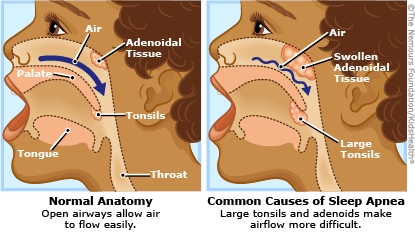Obstructive sleep apnea (OSA) is common in children. Your child's health care provider asked about your child's sleep and daytime activities, and did an exam. This information led the health care provider to suspect OSA. A sleep study might be needed to check how your child breathes during sleep.



Your child:

What is obstructive sleep apnea? Obstructive sleep apnea happens when the muscles of the throat relax during sleep, blocking airflow. Kids with OSA usually snore, but snoring does not always mean that a kid has OSA.
Obstructive sleep apnea can lead to restless sleep and daytime sleepiness. Other signs of OSA include:
Who gets obstructive sleep apnea? OSA is more common in:
How is obstructive sleep apnea diagnosed? The health care provider likely recommended a test called a sleep study (also called a polysomnogram) to diagnose sleep apnea. This study monitors snoring, breathing, body movements, brain waves, and oxygen and carbon dioxide levels overnight.
How is obstructive sleep apnea treated? If OSA is mild, the health care provider might wait to see if symptoms improve on their own because some kids will outgrow it.
Many kids with OSA have surgery to remove large tonsils or adenoids that are blocking the airway. Children who don't have big tonsils or adenoids or don't get better after surgery may need continuous positive airway pressure (CPAP). In CPAP therapy, a person wears a special mask during sleep. It's connected to a machine that pumps air to open the airways.